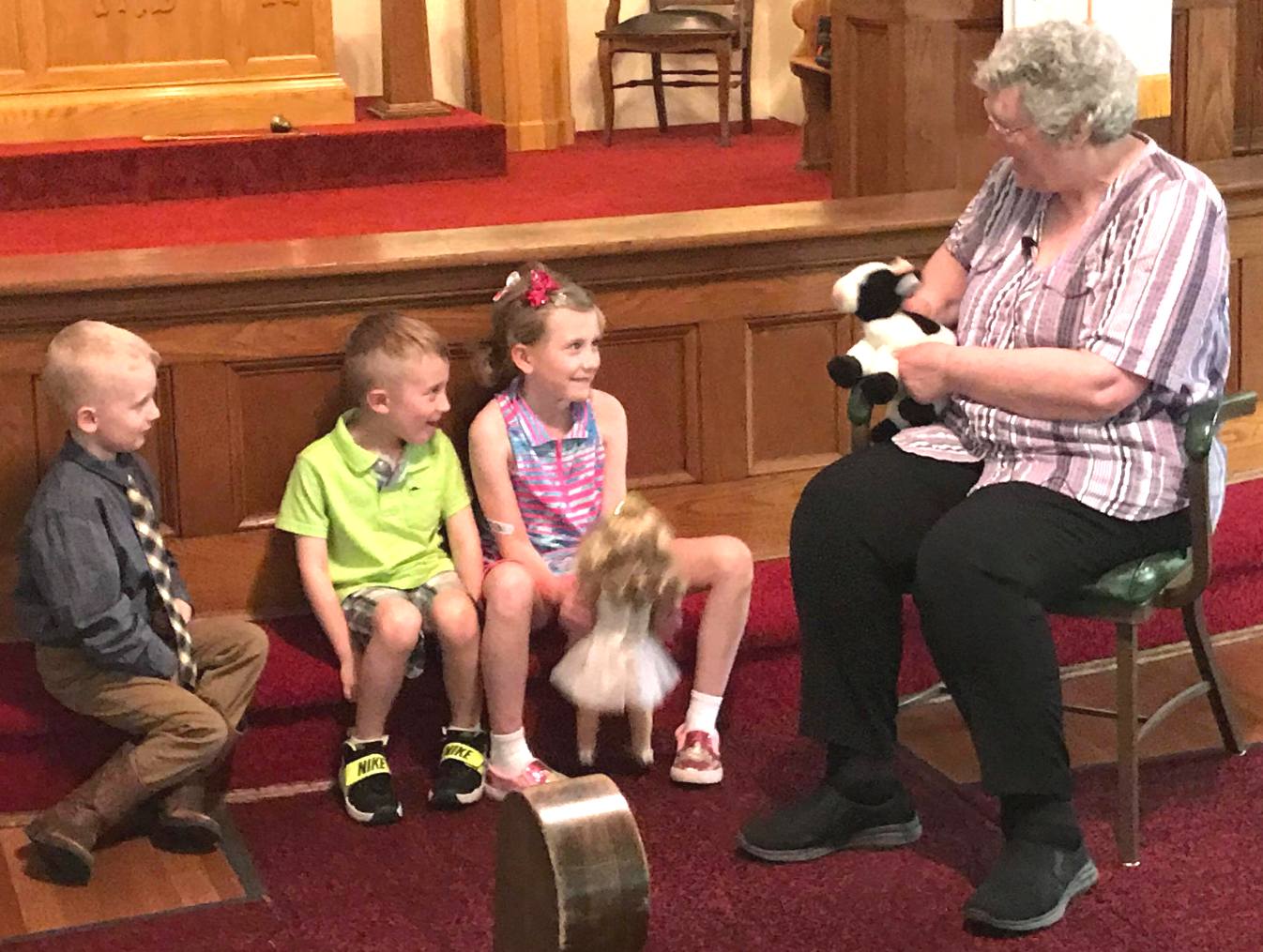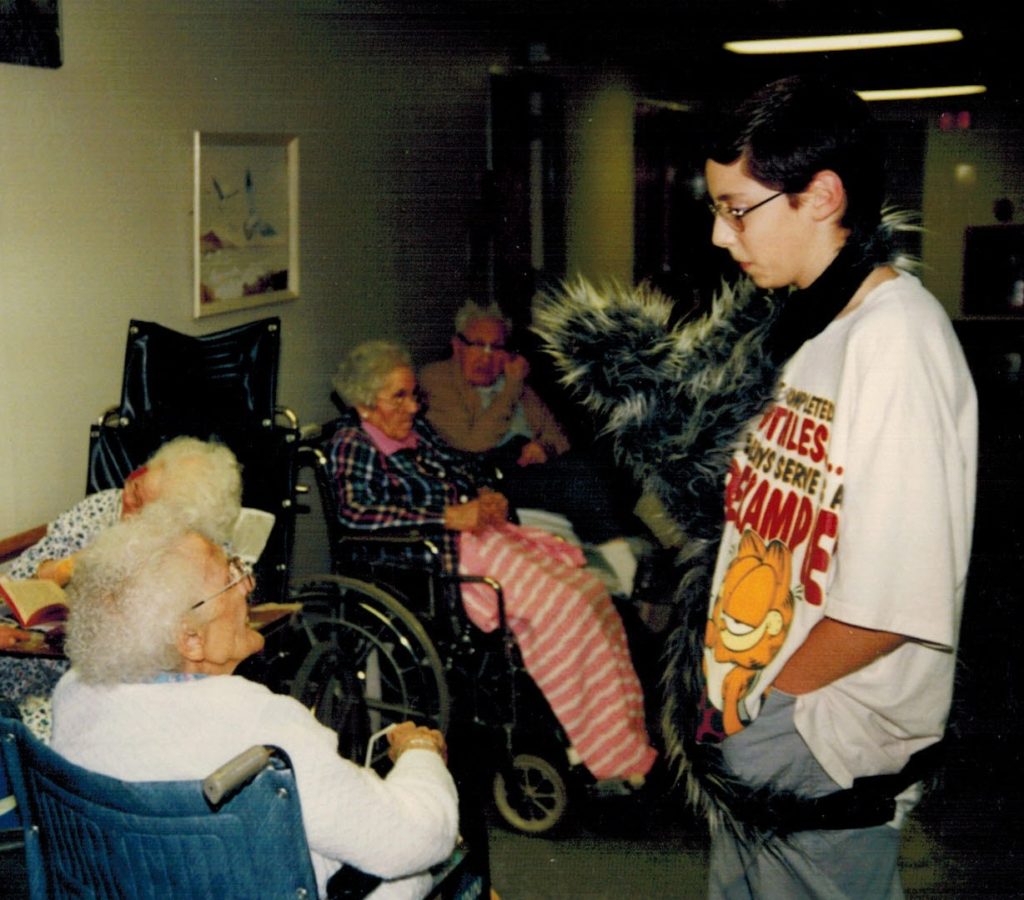When you and your puppet pal are up close and personal with a live audience, especially kids, there’s no telling what might happen! But going “up close and personal” is a big ingredient in personal puppet ministry, so thinking about audience interaction is super important.
In this installment of the Personal Puppet Ministry series…
Let’s see what lessons about audience interaction we can glean from my gig with my little cow puppet pal at Harpursville United Methodist Church on Ascension Sunday. This was Moochacha’s first encounter with children during worship services.
Here’s a quick encore:
“Moochacha Learns about Saying Goodbye”
Singing “Jesus Loves Me” with the entire audience had already been scheduled to close every performance. You can’t beat that message! Hopefully the children will enjoy singing along, and those who don’t know the song will learn it as we sing. If you like to sing, you might want to select a signature song to feature in all your appearances, too.
The script for “Moochacha Learns about Saying Goodbye” did not specify any other direct interaction with the audience. In fact, I’m embarrassed to admit that I hardly made any eye contact at all with the three kids who came forward for Children’s Time. My attention was glued onto Moochacha, talking to her, talking for her, and moving her head and body at appropriate times to give her a lively, responsive appearance.
 Fixating on my puppet was partly due to nervousness. My nerves are always on high alert when I conduct services as a lay speaker. Children’s Time is the biggest fear factor of all. Let’s face it, little kids flummox me. My own kids flummoxed me (still do, in their thirties!). Other people’s kids flummox me even more. So I was wound up tight as a tick, sitting in the hot seat facing three attentive children.
Fixating on my puppet was partly due to nervousness. My nerves are always on high alert when I conduct services as a lay speaker. Children’s Time is the biggest fear factor of all. Let’s face it, little kids flummox me. My own kids flummoxed me (still do, in their thirties!). Other people’s kids flummox me even more. So I was wound up tight as a tick, sitting in the hot seat facing three attentive children.
Working without a printed script, like a trapeze artist without a net, didn’t help my confidence level. I got even more rattled when my supposedly funny lines didn’t get so much as a chuckle from the whole church! I was sure my act was bombing big time. But I kept on going.
Feedback and lessons
Later, members of the congregation confirmed that they did indeed enjoy the humor. They were just being quiet.
Lesson learned: If the audience doesn’t laugh out loud at the humorous bits, keep smiling and keep going! Maybe they’re being quiet to make sure they don’t miss your next brilliant line. (Wouldn’t hurt to check the sound level, though. People can’t laugh at a joke they can’t hear.)
The kids’ parents also reported how fascinated the kids were with Moochacha. Look at the smiles in their photos!
Lesson learned: If I had paid closer attention to my little audience during the performance, their fascinated faces would have given me some much-needed courage.
You may have noticed in the recording that several unplanned elements of audience participation were added on the spur of the moment.
First, after I told Moochacha that everyone has to say goodbye sometimes, I asked the three kids if they’d ever had to say goodbye. Of course, they all had. Moochacha and I ad-libbed a brief comment or two, and then we returned to the scripted dialogue.
Lesson learned: It was smart to bring the children into the act with a question that they could answer very briefly. Our ad-libbed comments served to acknowledge the kids’ contributions in the discussion and also to segue quickly back to the script. Questions and transitions like that can be written into our future scripts very easily.
Something to think about: If time permits, asking more open-ended questions or follow-up questions, to delve a little deeper into the children’s individual experiences, would be a worthwhile option. The microphone would have to be set up differently to let the congregation hear what the kids say. The lapel mike clipped to my shirt picked up my voice, but not the kids.
The other last-minute addition of audience participation fit in nicely after the skit and song were over. Right before Moochacha said goodbye, I invited the kids to pet her. They eagerly took turns stroking her soft fur.
 Jackson told his parents that night that petting Moochacha was the high point of his day. Woot! This precocious boy undoubtedly was well aware that Moochacha is a stuffed animal, not a living creature. Nevertheless, petting her was a special moment for him and the other children.
Jackson told his parents that night that petting Moochacha was the high point of his day. Woot! This precocious boy undoubtedly was well aware that Moochacha is a stuffed animal, not a living creature. Nevertheless, petting her was a special moment for him and the other children.
Lesson learned: Don’t underestimate the power and joy of hands-on interaction, even with a make-believe puppet pal. It only took a minute to give all the kids the pleasure of petting Moochacha. Why not include that invitation at the end of all our performances for children?
Now, let’s put some ideas about audience interaction into general terms that you can apply to your own personal puppet ministry.
Scripted dialogue vs. spontaneous interaction
Spontaneous, unscripted, back-and-forth chatting can draw audience members into a dynamic conversation with you and your puppet pal. It’s fun, and it’s great for quickly building a bond with the audience. The unpredictable things audience members say and do might lead the conversation to a takeaway that is more personally meaningful to this audience than a preplanned message would have been. Then again, they might drag you down a time-sucking rabbit hole with little or no takeaway value.
A scripted conversation between you and your puppet pal is thought out, written, and rehearsed in advance. The puppeteer controls the performance (barring random catastrophes like your pal’s eyeball popping off and rolling under the pews). The conversation will stay on topic, and you’ll deliver your chosen message within the allotted time. But it can feel less personal. And you run the risk of sounding stiff and boring if you say your lines like a robot, instead of acting and sounding natural.
Which approach will work better for your personal puppet ministry?
That depends partly on the venue or occasion. If your personal puppet ministry goes on the road to places like nursing homes and hospitals, you and your puppet pal might share God’s love simply by chatting compassionately with the individuals you visit. My son, Jeff, and his critter puppet pal, Clyde, enjoyed doing that.

A puppet performance that serves as the children’s sermon in a church worship service is a different proposition. There, an explicit Christian lesson is expected. A script helps keep the message on track and prevents the time from getting away from you.
For example, I aim for ten minutes, tops, for Children’s Time at the churches I serve as lay speaker. That doesn’t leave a lot of surplus space for blathering, which I tend to do when I have no script to follow. Also, I have a specific topic in mind, to coordinate with the theme of the service. A scripted conversation is the best starting point for me to meet those requirements. As I learned on Ascension Sunday, I can always add a bit of audience participation to the script—enough to engage the kids but not enough to let them pull the discussion off course.
The “right” balance between scripted or spontaneous appearances also depends on the puppeteer’s abilities and comfort level as a performer. You might prefer the security of following a prepared script, as I do, especially if you have a knack for writing your own scripts and speaking your lines with natural expression. Spontaneous encounters might appeal to you more, if you are comfortable speaking off the top of your head to strangers, as Jeff is. You might choose a middle road by adding some audience participation to a loosely scripted conversation with your pal, if you are adept at guiding discussion toward your message.
Should scripted dialogue be memorized?
Performing your script from memory is ideal if you can deliver your lines without a lot of fumbling and forgetting. However, memorizing dialogue may be too much of a burden, especially for younger puppeteers. Performing in front of an audience is stressful enough without worrying that you’ll forget your lines. And, as I discovered, the attention spent on remembering lines isn’t available to spend on delivering the lines with good emotional expression or on watching the audience’s reactions.
An alternative option is reading the dialogue from a printed sheet (a style called Readers Theater), or at least having the script handy to refer to. Holding a script in your hand as you perform isn’t always practical, but often there are ways to camouflage it with a book or other prop.
The Readers Theater style worked nicely for Jeff and Clyde. Our church family is very easygoing. They didn’t mind seeing Jeff, in his preteen and teen years, holding his script. However, if you’re an adult performing for an audience with high expectations, conspicuously relying on a printed script may be unacceptable.
As I gain experience, I’m going to try to work from memory when my pal and I do short scripted appearances with children. Perfect recall is not one of my gifts, unfortunately. I’ll probably tuck a cheat sheet in my pocket in case I get stuck, especially for longer skits.
No matter what your gifts and circumstances, you and your puppet pal definitely have a gift of love to offer to a world that needs to receive it. Keep your eyes on your message, and you’ll be okay, even if you flub a line here or there. Share God’s love, and have fun doing it!
Don’t forget to share your ideas in a comment. We all can learn new tips and tricks from one another. ♥
—Linda
P. S. Check out the next post in the Personal Puppet Ministry series:
Puppet Props for a Puny Purse
If you missed previous posts, catch up here:
Puppet Grace
Picking a Puppet Pal
Picking a Puppet Pal, Part 2
Puppet Pal ~ Personality Plus
The Puppet Leaves the Pulpit
Puppet Ministry Resources page
Photographs of children are displayed in this post with the permission of their parents. Any form of reproduction of any child’s likeness from the photos on this site is prohibited.
